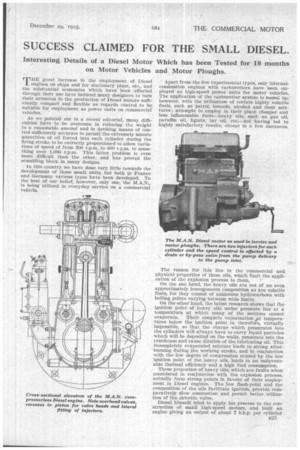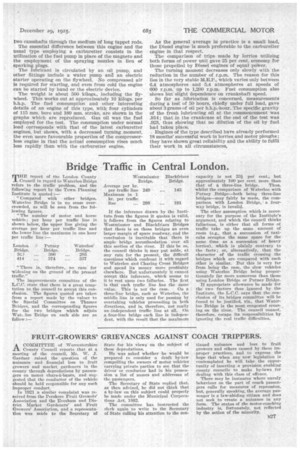SUCCESS CLAIMED FOR THE SMALL DIESEL.
Page 9

Page 10

Page 11

If you've noticed an error in this article please click here to report it so we can fix it.
Interesting Details of a Diesel Motor on Motor Vehicles Which has been Tested for 18 months and Motor Ploughs.
THE great increase in the employment of Diesel engines on ships and for stationary plant, etc., and the substantial economies which have been effected through their use have induced many designers to turn their attention to the production of Diesel motors sufficiently compact and flexible as regards 'control to be suitable for employment as power units On commercial vehicles.
As we pointed out in a recent editorial, many difficulties have to be overcome in reducing the weight to a reasonable amount and in devising means of control sufficiently accurate to permit the extremely minute ,quantities of oil forced into each cylinder during the firing stroke to be correctly proportioned to allow variations of speed of from 300 r.p.m. to 400 r.p.m. to something over 1,000 r.p.m. This latter problem is even more difficult than the other, and has proved the stumbling block in many designs.
• In this country we have done very little towards the development of these small units, but both in France and Germany various types have been developed. To the best of our belief, however, only one, the M.A.N., is being utilized in everyday service on a commercial vehicle. Apart from the few experimental types, only internalcombustion engines with carburetters have been employed as high-speed power units for motor vehicles. The application of the carburetter system is bound up, however, with the utilization of certain highly volatile fuels, such as petrol, benzole, alcohol and their mixtures; attempts to employ in their place cheaper and less inflammable fuels—heavy oils, such as gas oil, paraffin oil, lignite, tar oil, etc.—not having led to highly satisfactory results, except in a few instances.
The reason for this lies in the commercial and physical properties of these oils, which limit the application of the explosion process to them.
On the one hand, the heavy oils are not of an even approximately homogeneous composition as are volatile fuels, for they consist of numerous hydrocarbons with boiling points varying between wide limits.
On the other hand, the latest research shows that The ignition point of heavy oils under pressure lies at a temperature -at which many of the sections cannot evaporate. Their complete vaporization oat temperatures below the Ignition point is, therefore, virtually• impossible, so that the charge which penetrates into the cylinders will always have to carry liqaid particles which will be deposited on the walls, penetrate into the crankcase and cause dilution of the lubricating oil. This incompletely evaporated mixture leads to strong afterburning during the working stroke, and in conjunction with the low degree of compression caused by the low ignition point of the heavy oils, leads to an unfavourable thermal efficiency and a high fuel consumption.
These properties of heavy oils, which are faults when considered in conjunction with the explosion process, actually form strong points in favour of their employment in Diesel engines. The low flash-point and the composition of the oils facilitate ignition, provide comparatively slow combustion and permit better utilization of the calorific value.
Diesel himself tried to apply his process to the construction of small high-speed motors, and built an engine giving an output of about 7 b.h.p. per cylinder B25 at 600 r.p.m. Although his efforts in this direction cannot be considered as failures, yet development to any practical degree did not occur until later years, _when economy became a prime factor and when the difficulties of using heavy oils in an explosion motor became evident.
Two methods have been employed to render practicable the Diesel engine working without a compressor. These are the airless injection of oil under high pressure, which is known as the solid-injection system, and the fore-chamber system. As an example of the latter, there is the engine introduced by Vogel on one of the M.A.N. engines. In this the fuel enters a fore-chamber, where it mixes with the working air under a pressure higher than that usually adopted. It leaves the fore-chamber immediately after the dead centre, the fuel being pulverized as the air rushes into the cylinder.
A further group is formedby the fore-chamber engine, in which the pulverizing pressure is caused by explosion or detonation in the forechamber, -so that the pressure within --this exceeds that inside the cylinder. Characteristic engines were those built by the Motorenfabrik Deutz and, later, by the Steinbecker-Gesellschaft.
The third group of engines working One of the M.A.N. injectors, show'. on the fore-chamber principle ining its three simple components. eludes a considerable number. This
process is known as the Benz, and, in accordance with it, the fuel is sprayed in through the fore-chamber and, owing to its partial evaporation, gasification and combustion, the pressure in the fore-chamber is raised to more than that in the cylinder, so that pulverization into the cylinders takes place.
The compression pressures for this process have to be carefully selected to ensure correct combustion and quiet, economical working of the power unit. Detonation should take place only exceptionally, as during the starting of the unit from cold, but not during normal work. This, of course, does not exclude the possibility of allowing the combustion line to rise to as satisfactory an extent as in any Diesel engine with air spraying.
The essential features in obtaining good results with the three processes are :—(1) Most careful construction and shaping of the characteristic details, paying special regard to the unusually limited extent of their motion (this applying particularly to the fuel pump and Its governing, as well as to the injector) ; the shaping of the parts directly exposed to the combustion is also most important. (2) The paying of great attention to precision in manufacture, which must considerably surpass that ordinarily adapted in machinery ; this, again, applies particularly to the fuel pump and injector: (3) The careful designing and manufacture of other Items of the engine, the correct dimensioning of the details of the driving gear and adequate lubrication.
Governing is effected in every advanced type by an altellition of the volume capacity of the fuel pump, the B26 methods employed being :—(a) drain valve from the delivery chamber to the pump-inlet chamber—in other words, a fuel by-pass ; (b) altering the piston stroke.
Lorries equipped with such engines were exhibited last year at the German Motor Show in Berlin by BenzGaggenau, but this firm did not exhibit at the Show which concluded recently.
The M.A.N. (Maschinenfabrik Augsburg-Nurnberg A.G.) light mobile Diesel engine developed by the Augsburg works of that company and introduced at last year's Berlin Show also operates with nozzle pulverization. The combustion space, shaped in the form of a low cylinder, is supplied by two spraying nozzles, which obtain their fuel supply from a pump forming an essential part of the engine and governed by cams.
The chief characteristic of the M.A.N. injection system is the absence of moving parts after the delivery valve of the pump, which in this case is placed in the distributor of the piping for the compressed fuel. This method of injection is preferred to the control of the fuel valve by means of fuel pressure, because its construction and operation are more simple, which is a matter of great importance, especially in the case of power units on motor vehicles. Should the fuel contain some air, which is to be expected, considering the working conditions of a vehicle on the road, the whole injecting apparatus rejects that air, as the comparatively small-bore pipes offer no opportunity for the formation of air locks, which might lead to a stoppage of ignition.
The injector nozzles can each be dismounted, almost as easily as a sparking plug, by. unscrewing two nuts. Each consists of three simple details—the body of the nozzle, the nozzle plate and a fixing nut. The lateral position of the injectors leaves the cylinder head free and permits the easy arrangement of large valves for delivery and exhaust, so that, even at high speeds, a sufficient weight of air can enter 'each cylinder. The fuel supply is regulated by the relief valves to which we have already alluded, and which can be operated by hand or by a governor. One of our illustrations shows the general design of the engine. It has a cast-aluminium crankcase, carrying four cylinders of cast-iron in one block, whilst the cylinder heads are arranged in pairs. Inlet and exhaust valves are overhead and are operated separately by two camshafts through the medium of long tappet rods.
The essential difference between this engine and the usual type employing a carburetter consists in the utilization of the fuel pump in place of the magneto and the employment of the spraying nozzles in lieu of sparking plugs.
The lubricant is circulated by an oil pump, and other fittings include a water pump and an electric starter operating on the flywheel. No compressed air is required for starting, and even from cold the engine can be started by hand or the electric device.
The weight is about 500 kilogs., including the flywheel. This works out at approximately 10 kilogs. per b.h.p. The fuel consumption and other interesting details of an engine of this type, with four cylinders of 115 mm. bore and 180 mm. stroke, are shown in the graphs which are reproduced. Gas oil was the fuel employed for the test. The consumption under normal load corresponds with that of the latest carburetter engines, but shows, with a decreased turning moment, the even more favourable properties of the compressorless engine in that the actual consumption rises much less rapidly than with the carburetter engine.
AS the general average in practice is a small load, the Diesel engine is much preferable to the carburetter engine in that respect.
The comparison of trips made by lorries utilizing both forms of power unit gave 25 per cent. economy for those propelled by Diesel engines of equal power.
The turning moment decreases only slowly with the reduction in the number of r.p.m. The reason for this lies in the very stable which varies only between 6.4 atmospheres and 5.4 atmospheres at speeds of 600 r.p.m, up to 1,200 r.p.m. Fuel consumption also shows but slight dependence on crankshaft speed.
So far as lubrication is concerned, measurements during a test of 50 hours, chiefly under full load, gave about 3 grams of oil per b.h.p.-hour. The specific gravity of the fresh lubricating oil at the commencement was .914; that in the crankcase at the end of the test was .923, thus showing that no dilution of the oil by fuel had taken place.
• Engines of the type described have already performed 18 months' successful work in lorries and motor ploughs; they have shown.great reliability and the ability to fulfil their work in all circumstances.






























